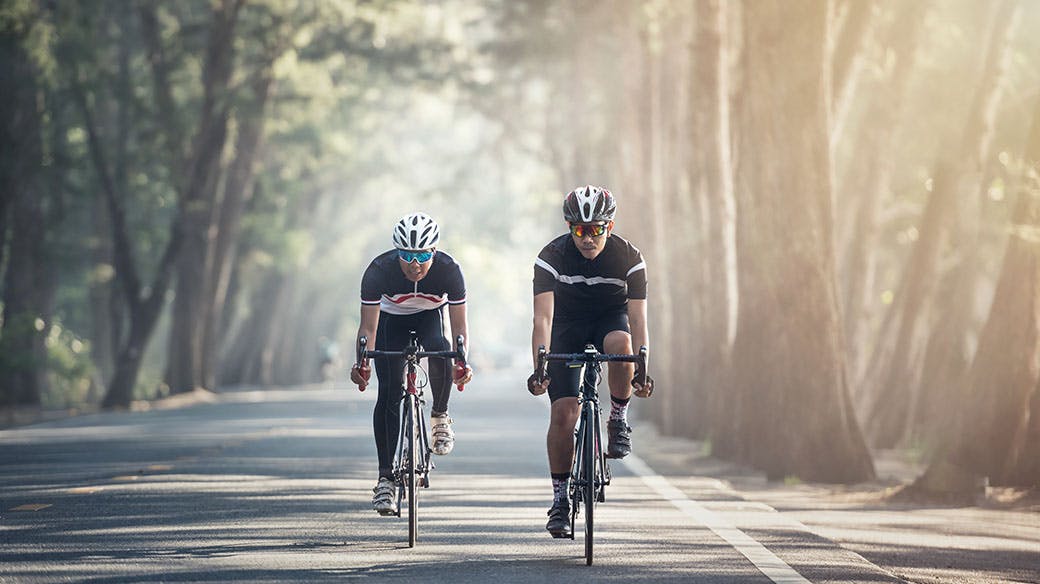Cycling is one of the high energy-burning ways to exercise (about 400 kcal per hour), making it a popular choice to help lose weight, get in shape and stay fit. However, if you don’t cycle the right way your body can actually be negatively impacted. So here are some cycling tips that pinpoint the potential problems in order to avoid them and take full advantage of this healthful and enjoyable activity.
Advantages of cycling
Depending on the rider’s weight and the incline, cycling for an hour generally burns 400-500 calories. Benefits to the body include reducing the risk of high blood pressure, type 2 diabetes caused by decreased insulin production or insulin resistance, heart disease, and stroke. Cycling also strengthens the muscles of the midsection, buttocks, hips and legs, especially in fore and back areas. Moreover, as a low-impact exercise, cycling can be suitable for those of an age when they are looking to preserve their joints and bones, especially if they have osteoarthritis of the knee or have had a surgical procedure necessitating them to avoid putting much weight on their hips, knees and legs.
Cycling the wrong way can be bad for your body
Cycling can have a range of detrimental effects on your body. The first danger is if your cycling posture isn’t suitable for your body type. This will give rise to unnecessary fatigue and/or pains. You need to ride your bike in the correct position. Set the saddle or seat at the right level for your height. The handlebar shouldn’t be too wide. When sitting, your legs should be slightly bent on the pedal at the low point of the rotation. If you can’t reach the pedal at the bottom, the saddle’s too high. When your feet are on the pedals, they should be parallel to the ground. Your knees should be at a 10- to 15-degree angle and your big toes should be parallel to the axis of the pedal.
In male cyclists, an improper bicycle saddle position puts pressure on the area between the sphincter and the scrotum, compressing the blood vessels, nerves and sensory points. If the area is compressed over an extended period, erectile dysfunction can occur. The solution is to choose a wide enough saddle covered with a cushioning material that absorbs the pressure. Another thing male cyclists may have to deal with is injury to the urethra or prostate which can cause blood in the urine. If the amount of blood is small, it will heal on its own within three days of stopping cycling. However, as blood in the urine can also be caused by stones, kidney disease or cancer, you might also consult your doctor to see if there are other factors involved.
Those who have any problem with their knee joints must be especially careful. They should avoid cycling in areas that involve much force, such as hills and rough terrains. Flattish and slower routes that avoid putting excessive pressure on knee joints will be preferable.
Cycling to lose weight and get in shape
If losing weight and getting in shape are your cycling goals, start at 60 rpm for 10 minutes, then increase the incline for 10 minutes, then return to 60 rpm on the flat for another 10 minutes. Keep that up 3 days a week for 3 weeks. As your body adapts you can kick it up to 80-90 rpm, alternating between 15 minutes of normal cycling, 15 minutes of incline cycling and another 15 minutes of normal cycling. Do those 3-4 days a week for at least another 3 weeks. Gradually increasing your speed and duration will steadily build your endurance so your body can adjust without overdoing it. Each cycling session should be no less than 40 minutes, at least 3-4 times a week. The amount of energy burned depends on your weight and the incline.
How to cycle safely and benefit the body
Besides the factors related to cycling that can be controlled, there are also certain external issues that are equally important, foremost of which is putting safety first. Always ride in bike lanes and preferably in parks where cycling is permitted. Stationary bike workouts can be a good option because you can keep up your regular cycling regimen regardless of the weather. Above all, if you’re unsure about anything, consult your doctor or a fitness professional for advice on the most suitable cycling style for your physical condition that will maximize the benefits and do you no harm.
In conclusion, cycling can be a good activity to burn calories and aerobicize in a way that is less impactful on knees than running, something which is particularly important for anyone with joint or bone issues. Moreover, cycling reduces high blood pressure, diabetes, heart disease, and stroke risk, among others. So, hop on a bike for a healthy life!
Customers of Krungthai-AXA Life Insurance interested in healthcare can find articles like this on more topics at https://www.krungthai-axa.co.th/th/health-advisories.
References
· Faculty of Medicine, Siriraj Hospital
https://www.si.mahidol.ac.th/th/healthdetail.asp?aid=1268
· Siriraj Piyamaharajkarun Hospital
http://www1.siphhospital.com/th/news/article/share/860/Ride-Bike
· Sports Authority of Thailand
https://bit.ly/3x4wui1
· Samitivej Hospital
https://bit.ly/3m83HEs
· King Chulalongkorn Memorial Hospital, the Thai Red Cross Society
https://bit.ly/3x8CjfG
· Pobpad website
https://bit.ly/3GWpDMt
· Phyathai Hospital
https://bit.ly/3OjyBpt


